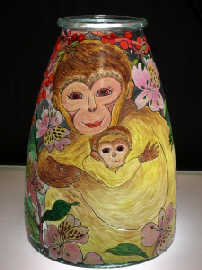 ** Silver stain
** Silver stain
Silver stain, which is available in shades of red, yellow, and orange, gets its name from the presence of silver nitrate in the stain. After firing, it turns golden, not silver-colored. It is unlike paint in that it actually changes the color of the glass, rather than simply covering it up with a dark line or wash.
Silver stains do not flow well from the brush, but since they are generally used to add accent colors (rather than detailed lines) this is not a major issue. They are often applied to the opposite side of the glass from vinegar trace and matt paints, and may be fired face down, with the silver stain resting on the kiln shelf.
Since silver stains are fired to around 1000 to 1100 degrees Fahrenheit, they may be fired at the same time as stained glass paints. Unlike glass paints, silver stains darken and grow deeper with each firing.
** Oil-based stained glass paints
The advantages of oil-based glass paints are that they come in more colors, are easier to work with, and are not effected by general atmospheric conditions. The major disadvantage of these paints are that they tend to be less consistent in application; although colors may be mixed like regular oil paints, they do not always mix easily or thoroughly and sometimes fire unevenly.
Oil-based paints, which use an oil-turpentine base, are generally fired to a slightly lower temperature than water-based paints. They tend to break up if fired to higher temperatures.
 Paints made for surfaces other than glass
Paints made for surfaces other than glass
It is possible to paint on glass with paints that are made for painting on other surfaces. All you need are some paint and a desire to experiment. Oil paints and acrylic paints can work, as will widely available alternatives such as model paint or automobile paint.
These kinds of paints can be brushed on by hand, but airbrushing frequently yields better results. The advantages of this approach to painting on glass are that the paints are easily found, relatively inexpensive, and can be mixed into virtually any color. In addition, no kiln is required, although firing in a kiln can help oil paints dry and adhere better.
